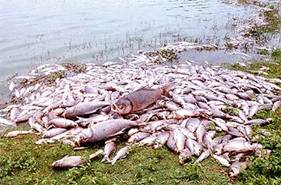On 8th May 2001, leading dailies in Karnataka reported a large-scale fish kill in Yennehole tank situated on the Ooty -
Mysore main road, generating widespread interest in probing the cause of this fish mortality. This episode reoccurred
recently leading to agitation from local people. This subsequently led to detailed field investigations involving the
characterisation of the water body and socio-economic implications of this episode. Water samples were collected
from different locations and subjected to physico-chemical-biological analyses to investigate the causative factors.
The results revealed low level of dissolved oxygen (1.6-2.4 mg/l) and high concentrations of most of the chemical
parameters such as sodium, potassium, etc. This led to asphyxiation and resulted in large-scale fish mortality, affecting
the livelihood of the economically backward fishing community. Further field investigations revealed that sewage
from the surrounding urban area contributed significantly to the change in water quality of the tank. Casual approach
adopted by the concerned government agencies and industries in disposal of waste is threatening most of the vital
components of our ecosystem. This necessitates immediate and appropriate policy measures to restore and manage
these fragile ecosystems all over the state to ensure that the livelihood of the poor fishermen and other dependents is
not affected by similar episodes.
Strategies should include
- Systematic review of the schedules of prevailing acts for conservation of ecosystems with emphasis on land,
water, forestry, wildlife, etc.;
- Setting up Joint Protected Areas Management Committees (active participation of local people, schools and
colleges and all stakeholders) to oversee conservation of aquatic and terrestrial habitats;
- Strict enforcement of the 'polluter pays' principle to protect the health of fresh waters;
- Empowering local panchayath raj institutions for conservation of aquatic systems, regulate fishing and maintain
traditional methods of sustainable fishing, and rewarding them for maintaining the diversity through special
grants;
- Restoration of affected ecosystems on a priority basis through ecologically sound management practices;
- Provision of laboratory facilities at selected lakes in each city / village for continuous status monitoring, through
involvement of local schools and colleges [amendment of school curriculum (if required) to ensure participation
of schools and colleges]. Active monitoring should be undertaken for predicting the likelihood of occurrence of
similar events in the future. Appropriate physico-chemical parameters along with plankton and microorganisms
should be analysed at regular intervals. The sampling and analyses should be carried out monthly or bi-monthly,
although the latter is preferable;
- Evolving a strategy to educate the general public. Based on scientific evidence, a regional task force should
prepare messages for the public. These messages must be clear to reduce economic consequences (pollution and
any such environmentally unsound practices).

HOME